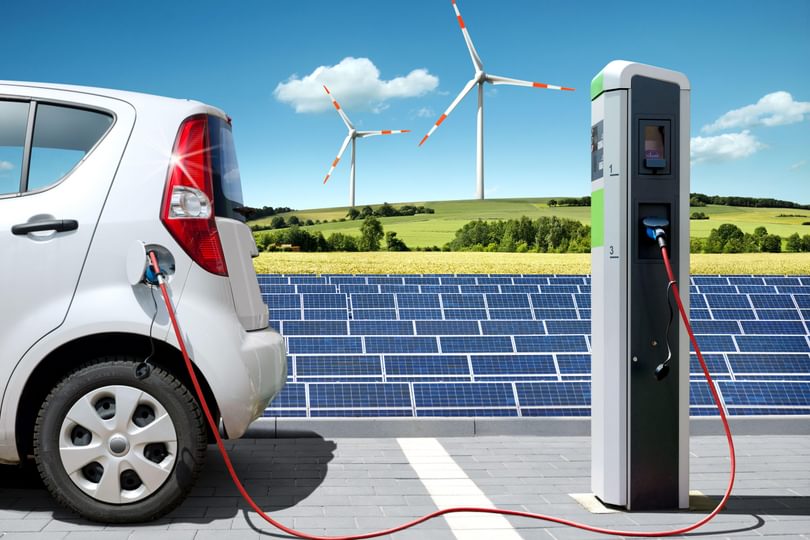
Researchers from the Oxford Martin Programme on Integrating Renewable Energy are designing peer-to-peer energy trading platforms that reward owners of solar panels, electric vehicles and other distributed energy resources for working together as a ‘federated power plant’ to support the grid.
Traditionally, power systems have been supplied by large fossil-fuel generation plants, with most people participating as passive consumers of electricity. Now, power systems are undergoing a fundamental transition, due to the rapid adoption of electric vehicles, roof-top solar, home batteries and other distributed energy resources.
Distributed energy resources allow previously passive consumers to become ‘prosumers’ – proactive consumers that actively manage their consumption, production and storage of energy. However, under existing electricity market arrangements, small-scale prosumers are stuck on retail supply contracts that individually meter their electricity usage, limiting the potential value of their energy resources.
For example, consider two cases:
- A single prosumer has solar panels and an electric vehicle parked at home during the day.
- There are two neighbours, one with solar panels, and the other with an electric vehicle.
From a power system perspective, the two situations are the same – local demand and supply are balanced, so there is no impact on upstream power generation or transmission.
However, this is not reflected by the retail market. In the first case, the prosumer can plug in their electric vehicle and charge it for free. In the second case, the electric vehicle owner will be charged at the same rate they would be if they were supplied by a power plant many miles away. The prosumer with solar panels will receive a feed-in tariff, but this won’t take into account the reduction in transmission losses and congestion their generation helped create.
Now though, retail electricity markets look set for disruption. A race is on between start-ups and established firms to develop peer-to-peer (P2P) energy trading platforms that would allow prosumers to sell energy directly to one another, rather than having to go through their retail supplier. Prominent examples include Piclo in the UK, the Brooklyn Microgrid in the US, Vandebron in the Netherlands, sonnenCommunity in Germany and Power Ledger in Australia.
These P2P energy trading platforms have a diverse range of business models and offerings for prosumers. Some proposals are modest and fit firmly within existing electricity market structures. For example, retail suppliers are developing platforms which offer their customers the ability to select their preferred sources of energy. On the other extreme, it has been proposed that retail suppliers could be replaced by a decentralised blockchain for P2P energy transactions. However, a key question remains unresolved: Can P2P platforms be designed to coordinate potentially millions of future prosumers to improve the overall operation of the power system?
Our recent research aims to address this. We argue that a natural development for P2P energy trading platforms is to facilitate transactions for services that support the grid, with groups of prosumers working together as a federated power plant – a ‘virtual power plant’ formed through P2P transactions.

Controlling large numbers of distributed energy resources together as a virtual power plant is key to realising their potential value for the power system. However, when these resources are owned by individual prosumers, it is challenging for direct control to provide sufficient flexibility and end-use functionality to be appealing.
The federated power plant concept helps address this. Rather than directly controlling prosumer resources like a traditional virtual power plant, a P2P platform would provide a market mechanism facilitating mutually beneficial energy transactions between subscribed prosumers and system operators responsible for managing network power flows.
We propose networked matching market theory as a new mathematical framework for P2P energy market design. Energy transactions could vary in terms of quantity, time-scale and acceptable variability, and may be network-location specific. The P2P platform would facilitate a price negotiation process, so that a mutually agreed set of energy transactions naturally emerges. The P2P platform could then advertise contracts for services to support the grid which groups of prosumers could fulfil.
A key objective of a P2P market is to provide a transparent mechanism that prosumers can trust to fairly balance their preferences and requirements. When operating as part of a federated power plant, each prosumer would retain control over their energy resources, and define the energy transactions they are willing and able to take part in.
P2P energy trading platforms could provide value even on a small scale, by facilitating prosumer-to-prosumer energy transactions. As new subscribers join and the platform grows, federated power plant operation at the scale of a traditional virtual power plant would become possible. The lack of a minimum size requirement means there are fewer barriers to entry, and allows for the gradual building of trust and experience. This could have a system-wide benefit by increasing competition for the provision of prosumer coordination services.
The real opportunity for P2P energy trading platforms is to be the technology that aligns the interests of electricity consumers, prosumers and power system operators. By incentivising coordination between potentially vast numbers of future prosumers, they have the potential to reduce energy costs, increase reliability and reduce pollution.
This blog draws from recently published work by Thomas Morstyn, Niall Farrell, Sarah J. Darby, Alexander Teytelboym and Malcolm D. McCulloch from the Oxford Martin Programme on Integrating Renewable Energy.
Access the paper, “Using peer-to-peer energy-trading platforms to incentivize prosumers to form federated power plants”, published in Nature Energy, can be found here.
Access the paper, “Bilateral Contract Networks for Peer-to-Peer Energy Trading”, published in IEEE Transactions on Smart Grid, can be found here.
This opinion piece reflects the views of the author, and does not necessarily reflect the position of the Oxford Martin School or the University of Oxford. Any errors or omissions are those of the author.

